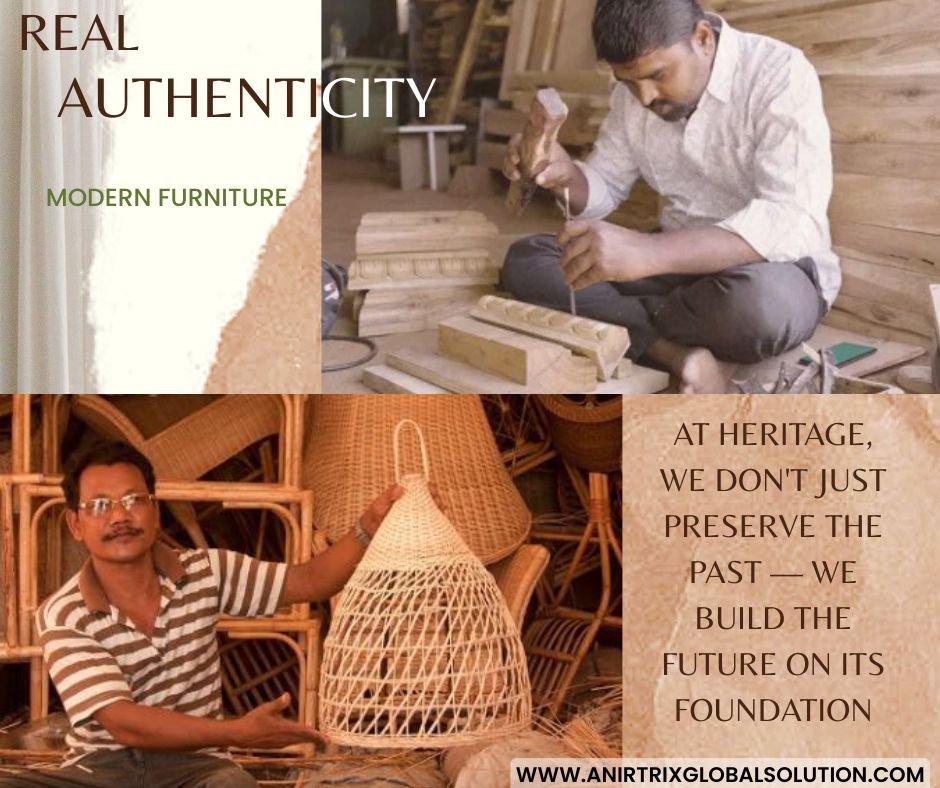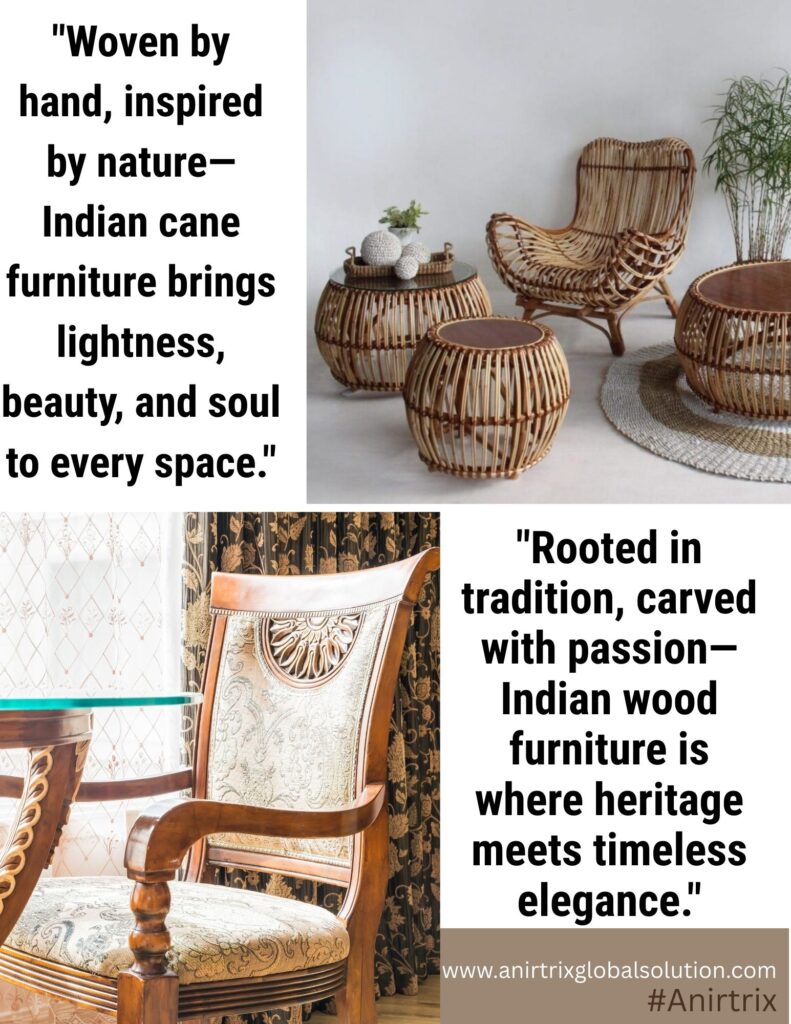Timeless Craftsmanship: Exploring Different Woods & Artistic Styles in Indian Furniture
Dive into the rich heritage of Indian furniture as we explore different types of wood like Sheesham, Teak, and Mango, and discover the traditional art forms like inlay work, carving, and painting that define Indian furniture design.

Introduction: The Soul of Indian Homes Lies in its Furniture
Indian furniture is not just about utility—it’s a cultural expression passed down through generations. From intricately hand-carved chairs to vibrant painted cabinets, every piece tells a story of tradition, craftsmanship, and natural beauty. One of the biggest reasons Indian furniture stands out globally is its rich variety of woods and artistic designs that blend durability with beauty.
If you’re looking to understand why Indian furniture continues to charm homeowners around the world, it all begins with the material—the wood—and the soul—the art.
1. Sheesham Wood (Indian Rosewood): The Crown Jewel of Indian Furniture
Popular For: Strength, beautiful grains, termite resistance
Found In: Rajasthan, Punjab, Uttar Pradesh
Sheesham wood is arguably the most popular hardwood in Indian furniture making. It boasts a rich reddish-brown color with darker streaks that lend a luxurious touch to any piece. Its high durability and resistance to wood-boring insects make it ideal for long-lasting furniture like beds, dining tables, and wardrobes.
Best Used For: Hand-carved beds, ornate cabinets, temple furniture
Fun Fact: Artisans love Sheesham because it carves like butter but lasts like stone.
2. Teak Wood: The Royal Wood of India
Popular For: Water resistance, durability, smooth finish
Found In: Central and Southern India
Teak wood is often considered the king of hardwoods. Its high oil content makes it resistant to water, decay, and insects, which is why it’s a top choice for luxury indoor and outdoor furniture. Teak’s natural golden-brown hue deepens with age, making every piece more beautiful over time.
Best Used For: Outdoor benches, premium sofa sets, antique-style dressers
Design Highlight: Often left with minimal carving to let the grain shine naturally.
3. Mango Wood: The Eco-Friendly All-Rounder
Popular For: Sustainability, affordability, light-to-medium tones
Found In: Maharashtra, Karnataka, and Gujarat
Mango wood is a by-product of mango fruit farming, making it a sustainable choice. It’s relatively softer than Sheesham or Teak but easy to work with and takes stains or paints very well. That’s why it’s often used in colorful, distressed-style furniture.
Best Used For: Painted dressers, rustic coffee tables, modern boho furniture
Eco Angle: Choosing mango wood helps reduce waste in the fruit industry.
4. Acacia Wood: The Rustic Charmer
Popular For: Scratch resistance, natural shine, earthy texture
Found In: Tamil Nadu, Andhra Pradesh
With its natural resistance to fungi and aesthetic appeal, Acacia wood is great for pieces that need to withstand wear and tear. It’s perfect for rustic, farmhouse-style furniture that’s both trendy and timeless.
Best Used For: Dining sets, bookshelves, industrial-style furniture
Design Appeal: Looks best when kept raw with visible knots and grains.
5. Sal Wood: The Heavy-Duty Performer
Popular For: Toughness, resistance to moisture and insects
Found In: Bengal, Bihar, Assam
Sal wood is dense and durable, making it an excellent material for structural elements like frames and doors. Though not as decorative as Teak or Sheesham, it’s often used in combination with other woods.
Best Used For: Door frames, heavy-duty wardrobes, support structures
Architectural Use: Often used in traditional Indian homes for main doors due to its toughness.

Artistic Traditions That Bring Indian Furniture to Life
1. Hand Carving: A Heritage of Precision
Indian artisans, especially from Rajasthan and Saharanpur, are globally admired for their exquisite hand-carving skills. Whether it’s floral patterns, mythological scenes, or geometric motifs, carving adds soul to wooden surfaces.
Cultural Touch: Jali work (lattice carving) brings both privacy and style to Indian interiors.
2. Bone and Metal Inlay: A Royal Finish
This centuries-old technique involves embedding bone, brass, or even mother of pearl into wood, creating intricate, shimmering designs. Mostly used in decorative pieces like side tables, mirror frames, and jewelry boxes.
Design Hub: Udaipur and Jodhpur in Rajasthan are the capitals of inlay furniture.
3. Painted Furniture: A Riot of Colors and Culture
Hand-painted furniture, especially from regions like Kashmir and Rajasthan, often features bold floral patterns, elephants, camels, and peacocks. These pieces are a celebration of India’s vibrant culture.
Perfect For: Accent furniture, kids’ rooms, or bohemian-style décor
4. Distressed Finish: The Vintage Aesthetic
Inspired by both colonial and indigenous design, the distressed style gives furniture a timeworn charm. Mango wood is often the base, painted and sanded down to reveal layers.
Appeal: Gives your space a cozy, lived-in feel that’s stylishly imperfect.
Why Indian Furniture Wins Hearts Worldwide
- Sustainable Craft: Many Indian woods are sourced ethically, with a rise in reclaimed wood usage.
- Handcrafted Quality: Unlike mass-produced furniture, Indian pieces often carry the personal touch of the artisan.
- Cultural Identity: Every carving, curve, and color reflects a part of India’s artistic and spiritual heritage.
Final Verdict: Furniture That’s Functional, Artistic & Rooted in Culture
Indian furniture is more than just wood and nails—it’s history carved into functional art. Whether you’re drawn to the warm elegance of Teak, the sustainable charm of Mango wood, or the bold vibrancy of painted designs, Indian furniture offers something for every home and heart.
As the world leans into authenticity, sustainability, and storytelling through design—Indian wooden furniture proudly checks all those boxes with centuries of elegance behind every piece.
FAQs
Q1: Which wood is best for long-lasting Indian furniture?
A: Teak and Sheesham are the most durable and termite-resistant options, ideal for heirloom pieces.
Q2: Is mango wood furniture durable?
A: Yes, it’s quite strong and eco-friendly, though better suited for indoor use.
Q3: Where is hand-carved furniture made in India?
A: Saharanpur (Uttar Pradesh) and Jodhpur (Rajasthan) are major carving hubs.
Q4: Is painted furniture high-maintenance?
A: Not necessarily—modern finishes are more durable, but avoid excessive water exposure.
Q5: Can I mix different woods in one room?
A: Absolutely! Mixing Teak with Mango or painted pieces adds personality to your space.


